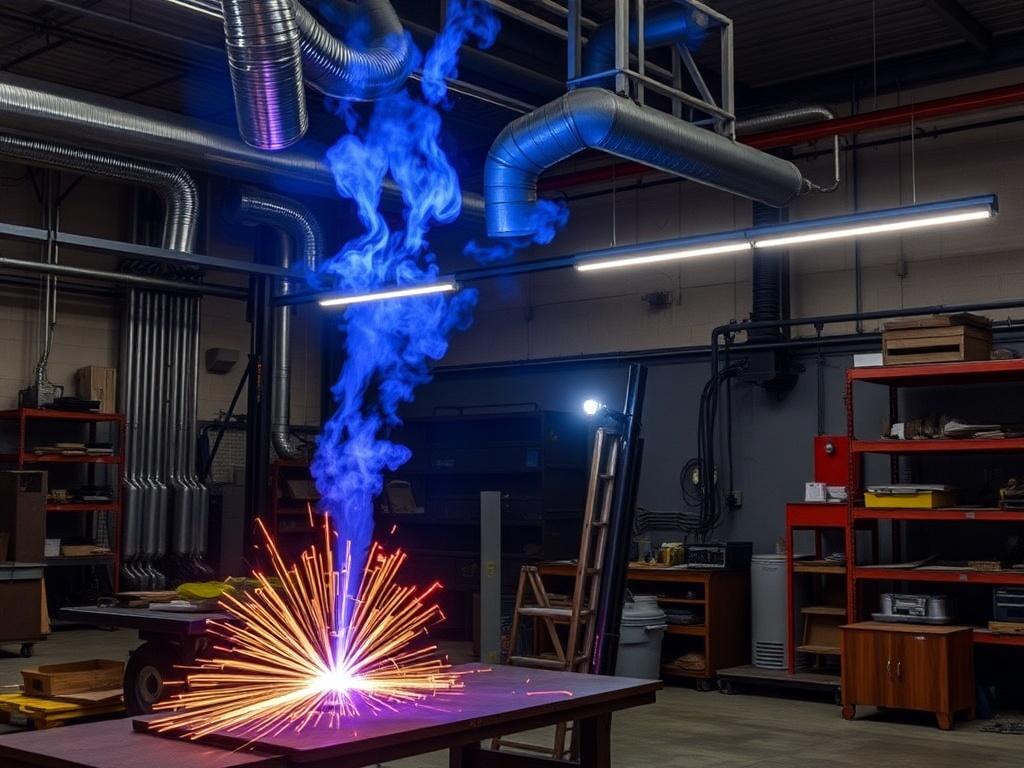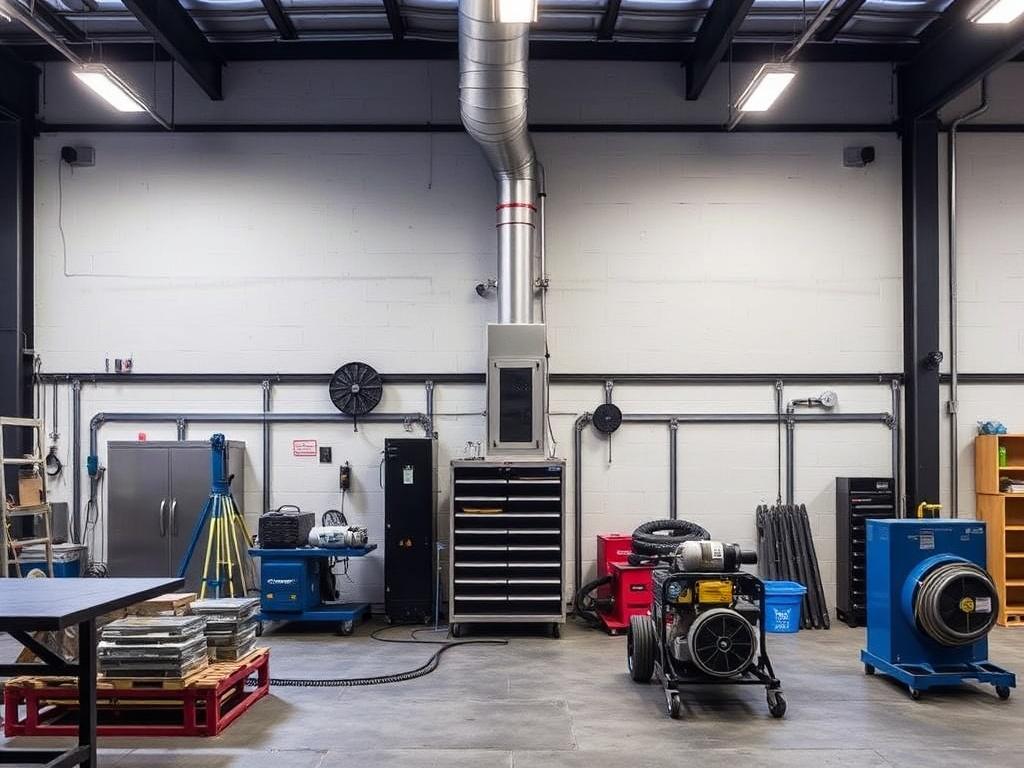
Welding workshops are hubs of creativity and productivity, where skilled artisans bring metal to life through heat and precision. However, the very nature of welding presents inherent health and safety challenges, with fumes, gases, and airborne particles posing risks to welders and anyone nearby. Effective ventilation solutions for welding workshops are crucial not only for complying with occupational health standards but also for creating a safe, comfortable, and efficient working environment.
In this comprehensive article, we will explore everything you need to know about ventilation solutions for welding workshops, detailing the types of ventilation systems available, the risks associated with inadequate ventilation, and best practices that ensure a safe workshop setup. Whether you run a small metal fabrication shop or a large industrial welding workshop, understanding and implementing proper ventilation can significantly impact the health of your workforce and the quality of your work.
The Importance of Proper Ventilation in Welding Workshops
When discussing ventilation solutions for welding workshops, it’s essential first to understand why proper ventilation matters so profoundly. Welding processes generate a variety of hazardous by-products, including fumes, gases like ozone and nitrogen oxides, and microscopic metal particulates. These substances can cause immediate issues such as headaches, dizziness, and respiratory irritation, as well as chronic health problems including lung disease and metal fume fever.
Effective ventilation serves several functions:
- Protects worker health: By removing or diluting harmful fumes and gases, ventilation reduces exposure and health risks.
- Improves air quality: Good ventilation controls airborne particles and keeps the air fresh and breathable.
- Enhances efficiency: Maintaining a comfortable environment helps workers focus and perform better.
- Prevents fire hazards: Ventilation can help to disperse combustible gases that accumulate during welding.
- Complies with regulations: Most countries have stringent rules about workshop ventilation, making it legally required.
Simply put, proper ventilation is not a luxury; it is an absolute necessity for any welding operation. Neglecting this critical aspect can result in serious health consequences and even costly penalties.
Health Hazards Associated with Poor Ventilation in Welding
Welding fumes contain complex mixtures of various metal oxides and gases that can be extremely harmful if not properly controlled. Below is a list of common risks faced due to inadequate ventilation solutions for welding workshops:
| Hazard | Description | Potential Impact |
|---|---|---|
| Metal Fume Fever | Short-term exposure to welding fumes like zinc oxide can cause flu-like symptoms including chills and fever. | Temporary illness that can incapacitate workers temporarily. |
| Lung Disease | Prolonged inhalation of welding fumes can lead to chronic bronchitis, asthma, or pulmonary fibrosis. | Long-term respiratory problems, decreased lung function. |
| Manganese Poisoning | Exposure to manganese fumes can damage the nervous system causing symptoms similar to Parkinson’s disease. | Neurological damage, affecting motor skills and cognition. |
| Cancer Risk | Some components of welding fumes, such as hexavalent chromium, are recognized carcinogens. | Increased risk of lung and other cancers. |
| Ozone and Nitrogen Oxides | These gases irritate the respiratory tract and can cause inflammation and damage over time. | Respiratory distress, increased susceptibility to infections. |
| Explosive Atmospheres | Accumulation of flammable gases from welding can create fire or explosion hazards. | Severe safety incidents, property damage, injury. |
Given these serious hazards, it becomes clear why adopting effective ventilation solutions for welding workshops is a priority for safety managers and shop owners.
Types of Ventilation Solutions for Welding Workshops
Ventilation systems are designed to control airborne contaminants by either removing polluted air, supplying clean air, or a combination of both. The two primary types used in welding shops are local exhaust ventilation (LEV) and general or dilution ventilation. Let’s look deeper into each of these options.
Local Exhaust Ventilation (LEV)
Local exhaust ventilation is the most effective method for controlling welding fumes because it captures contaminants at or near the source—right where the welding arc is producing harmful gases. LEV systems consist of a hood, ductwork, a fan, and a filtration or exhaust stack. The hood should be positioned as close to the welding operation as possible without interfering with the welder’s work.
Some key advantages of LEV systems include:
- High efficiency in removing fumes: Captures hazardous particles before they disperse into the environment.
- Flexibility: Movable arms and hoods can adjust to various welding stations.
- Improved worker exposure levels: Substantially reduces breathing zone contaminants.
Common LEV configurations for welding workshops include:
- Portable extraction arms: Flexible arms with conical or slot hoods that can be positioned for smaller or multiple welding stations.
- Downdraft tables: Work surfaces that pull fumes downward through perforated tops, ideal for smaller and precision welding tasks.
- Enclosures with exhaust hoods: Full or partial enclosures that isolate the welding zone and remove fumes.
General or Dilution Ventilation
General ventilation, or dilution ventilation, works by supplying fresh air and diluting contaminated air within the workshop. This method is less targeted than LEV but is often used in larger spaces as a supplementary system or where LEV is not feasible for every workstation.
There are two main types of general ventilation systems:
- Natural Ventilation: Uses open windows, vents, and doors to encourage airflow.
- Mechanical Ventilation: Employs fans and ducts to move air, either by exhausting contaminated air or supplying fresh air.
While general ventilation helps reduce airborne contaminants when set up correctly, it cannot replace the efficiency and protection offered by proper local exhaust ventilation.
Design Considerations for Ventilation Systems in Welding Workshops
When planning ventilation solutions for welding workshops, multiple factors must be carefully considered to optimize safety and performance:
1. Airflow Rate Requirements
Sufficient airflow is necessary to capture welding fumes effectively. The airflow rate depends on the welding type, the number of welders, the size of the workshop, and the level of contaminants present. For example, a typical extraction arm might require an airflow velocity of 100 to 150 feet per minute at the hood opening to capture fumes successfully.
2. Positioning of Extractors and Hoods
To maximize fume extraction, hoods and extractor arms must be positioned as close as possible to the welding arc—within 6 to 8 inches is ideal—to minimize the dispersion of fumes. Movement or poor placement reduces efficiency dramatically.
3. Filtration and Air Cleaning
Especially in enclosed welding workshops, incorporating proper filters like HEPA filters or electrostatic precipitators can trap fine particles, preventing them from recirculating in the air or being expelled as pollutants into the outdoors.
4. Noise Control
Ventilation fans and ductwork can create audible noise that disrupts the work environment. Using vibration isolators, silencers on duct runs, or locating noisy equipment away from workstations can improve comfort.
5. Energy Efficiency
Ventilation systems consume energy and can affect heating or cooling loads in workshops. Efficient fans, variable speed drives, and smart control systems contribute to energy savings.
6. Maintenance Access and Ease
Regular cleaning and mechanical upkeep are vital for system reliability. Designing accessible ducts, changeable filter cartridges, and easy-to-service fan assemblies ensures long-term performance.
Common Ventilation Solutions Used in Welding Workshops

Here is a detailed list of popular ventilation solutions that welding professionals and workshop managers commonly implement:
| Ventilation Solution | Description | Pros | Cons |
|---|---|---|---|
| Portable Extraction Arms | Flexible arms with adjustable hoods that capture fumes near the source. | Highly efficient, adaptable, easy to reposition. | Limited reach; can be obstructive if poorly positioned. |
| Downdraft Tables | Work tables with integrated ventilation pulling fumes downward. | Good for small parts; promotes ergonomic posture. | Not suitable for large or heavy welding tasks. |
| Ventilated Enclosures/Booths | Physical barriers with dedicated exhaust system for fume containment. | Excellent containment; reduces fume spread. | Costly; may limit worker movement. |
| General Mechanical Ventilation | Fans and ducts providing air extraction or supply across the whole workshop. | Improves overall air quality; can be combined with LEV. | Less efficient at controlling fumes at the source. |
| Personal Respirators | Wearable masks or respirators that filter inhaled air. | Vital backup for ventilation systems; portable. | Can be uncomfortable; dependent on user compliance. |
Steps to Implement Effective Ventilation Solutions in Your Workshop

Now that you understand the various ventilation options, here’s a step-by-step guide to implementing effective ventilation solutions for welding workshops:
- Conduct a Risk Assessment: Evaluate the welding processes, the types of metals used, and the number of welders to identify specific fume hazards.
- Measure Current Air Quality: Use air sampling and monitoring to understand fume concentrations and worker exposure.
- Design Customized Ventilation: Choose ventilation solutions based on your assessment. In most cases, a combination of local exhaust ventilation and general ventilation is recommended.
- Install Equipment Properly: Position extraction arms close to weld points, ensure ducts are correctly sized, and that exhaust fans are powerful enough for your space.
- Train Staff: Educate welders on the importance of ventilation and correct use of extraction devices and personal protective equipment.
- Maintain Systems Regularly: Schedule inspections, clean ducts and filters, and test airflow to sustain optimal performance.
Real-Life Examples of Ventilation Solutions in Action
To give you a better perspective, here are some real-world examples illustrating the successful implementation of ventilation solutions for welding workshops:
Example 1: Medium-Sized Fabrication Workshop
A medium-sized metal fabrication shop with 10 welders installed an extensive LEV system comprising portable extraction arms at each welding station combined with a central dust collection system. They supplemented this with mechanical general ventilation to maintain fresh air. After installation, the workshop noted a 70% reduction in airborne contaminants, fewer worker sick days, and improved production quality.
Example 2: Automotive Repair Shop
An automobile repair shop offering bodywork and welding services relied on natural ventilation, with open doors and windows. Recognizing the health risks, they invested in portable extraction arms and ventilated enclosures for their welding bays. They also integrated a fan-based general ventilation system to improve airflow. The improvements led to full regulatory compliance and significantly improved employee satisfaction.
Example 3: Aerospace Manufacturing Facility
In a high-tech aerospace manufacturing environment, welders work with exotic alloys producing highly toxic fumes. Their ventilation solution includes advanced LEV systems with high-efficiency particulate air (HEPA) filters, intelligent airflow monitoring systems, and continuous air quality sensors. This high investment ensures the safety of staff and the quality demands of aerospace components.
Maintenance Best Practices for Welding Workshop Ventilation Systems
Ventilation equipment requires ongoing maintenance to function correctly. Neglecting maintenance can lead to reduced airflow, higher fume concentrations, and increased health risks. Here are essential maintenance tips:
- Regularly inspect extraction arms, hoods, and ducts for blockages, damages, or leaks.
- Change filters as recommended by manufacturers; clogged filters reduce suction efficiency.
- Check fan motors and belts to ensure smooth operation and replace worn parts promptly.
- Keep records of maintenance activities to track performance and schedule future inspections.
- Train employees to report ventilation problems immediately.
Balancing Costs and Benefits: Investing in Welding Workshop Ventilation

It’s understandable that ventilation solutions represent a significant investment that some smaller welding shops may hesitate to make. However, the long-term benefits far outweigh upfront expenses. Consider these points:
- Health Cost Savings: Reduced medical claims and sick days lower indirect costs.
- Compliance Avoids Fines: Non-compliance with health regulations can result in penalties and work stoppages.
- Improved Productivity: Comfortable, healthy welders perform better and produce higher-quality work.
- Equipment Longevity: Proper ventilation reduces buildup of corrosive fumes that damage workshop infrastructure.
- Reputation: Demonstrating a commitment to safety improves your business image with customers and employees.
When choosing ventilation solutions for welding workshops, it’s helpful to perform a cost-benefit analysis that includes these factors to justify the investment and select solutions that best match your operational scale.
FAQs: Common Questions About Ventilation Solutions for Welding Workshops
Q: Can personal protective equipment replace ventilation?
A: No. While respirators and masks are vital protective gear, ventilation solutions reduce the airborne contaminants source-side and protect everyone in the environment, not just the wearer.
Q: How often should ventilation systems be inspected?
A: Ideally, ventilation systems should be inspected monthly, with periodic detailed maintenance every 6-12 months depending on intensity of use and manufacturer recommendations.
Q: Are there legal requirements for welding workshop ventilation?
A: Yes. Many regulatory bodies like OSHA (in the USA) and HSE (in the UK) have detailed standards specifying ventilation parameters and monitoring to protect workers.
Q: How do I know if my ventilation system is adequate?
A: Air quality testing and monitoring worker health symptoms can indicate adequacy. Using professional assessments and sensors can help verify system performance.
Q: What is the difference between local exhaust ventilation and general ventilation?
A: Local exhaust ventilation captures welding fumes at the source, while general ventilation dilutes fumes throughout the entire workshop environment. Both combined offer optimal protection.
Conclusion: Prioritizing Ventilation Solutions to Safeguard Your Welding Workshop
Proper ventilation solutions for welding workshops play a pivotal role in protecting workers from hazardous fumes, maintaining workplace comfort, and ensuring operational efficiency. By understanding the types of ventilation available, recognizing health hazards associated with welding fumes, and carefully designing and maintaining ventilation systems, shop managers can create environments that foster both productivity and safety.
If you are a welding workshop owner or safety manager, take a close look at your existing ventilation arrangements today. Investing in well-designed ventilation solutions is investing in the health and future of your workforce and business. Through smart planning, ongoing maintenance, and staff education, you can keep your welding workshop a safe, breathable, and efficient space for all.
